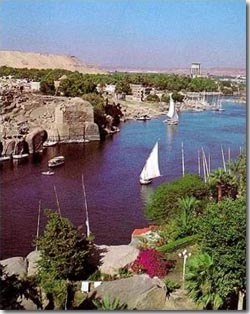| |
|||||
|
|||||
ELEPHANTINE ISLAND -- ABU
-- YABU -- KOM |
|||||
 |
|
||||
Elephantine Island has also been referenced as Kom, after the principle god of the island, Khnum. The island was considered the home of this important Egyptian god and the ruins of his Temple are here. This structure dates back to the Pharaoh-Queen Hatshepsut of the 18th Dynasty, but there are references to a Temple of Khnum on the island as early as the 3rd Dynasty of the Old Kingdom. There are also ruins of a Temple of Satet, who was Khnum's female counterpart (the three local deities were foremost Khnum, but also Satet and a local Nubian goddess Anqet. These gods were worshipped here since the earliest dynasties), also build by Queen Hatshepsut, a shrine to Hekayib from the 6th Dynasty, a local governor who was deified after his death. His cult flourished during the middle kingdom, and some fine statues from the shrine are now in the museum. You will also find a 3rd Dynasty granite step pyramid which is now just visible, and to the north, the mud-brick vaults of the late period which housed the bodies of the royal rams. On the south end of the island is a small one room Ptolemaic temple which was constructed from materials removed from the Kalabsha Temple. Here, there are decorations attributed to the Nubian Pharaoh Arkamani from the 3rd century BC The building seems to have been finished by the Romans with reference to Caesar Augustus. There has been ongoing excavations at the town for many years and some of the finds along with many other artifacts, including a mummified ram of Khnum, are located in the Elephantine Museum. Other artifacts and archaeological sites have been removed or destroyed. Prior to 1822, there were temples of Thutmose III and Amenhotep III, both of which were relatively intact, but they were destroyed in that year by the Turkish government. A rare calendar, known as the Elephantine Calendar, dating to the reign of Tuthmosis III, was found in fragments, and a Papyrus dating to the 13th Dynasty and known as the Elephantine Papyrus was also discovered. It is unclear where these artifacts are currently located. A stela with inscriptions commemorating the repairs made on a 12th Dynasty fortress which honored Senwosret III was also found, and is now in the British Museum.
|
|||||
Home | Nile Valley | Dynasties | Wealth | Divinity | Temples | Hieroglyphs | Mysteries
|
|||||